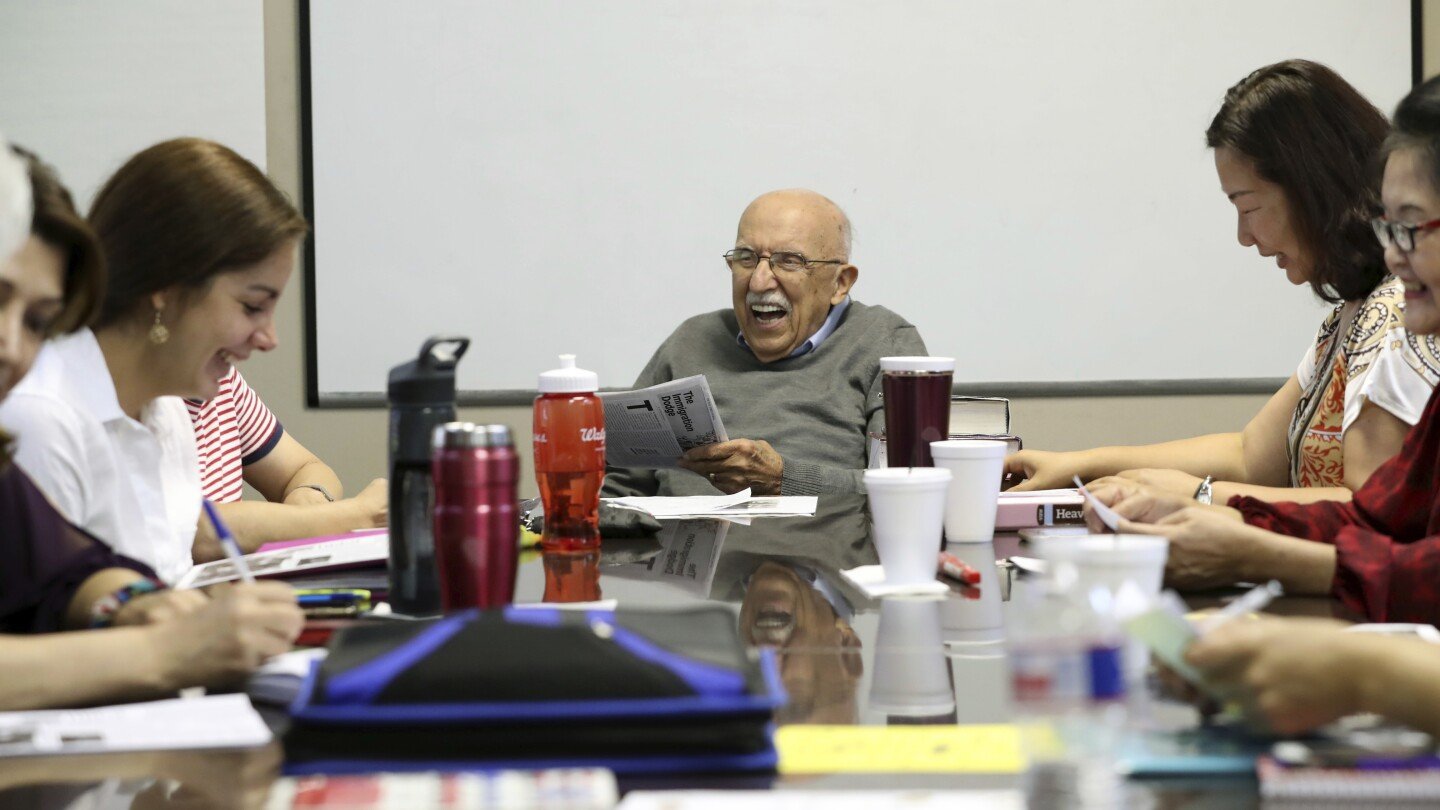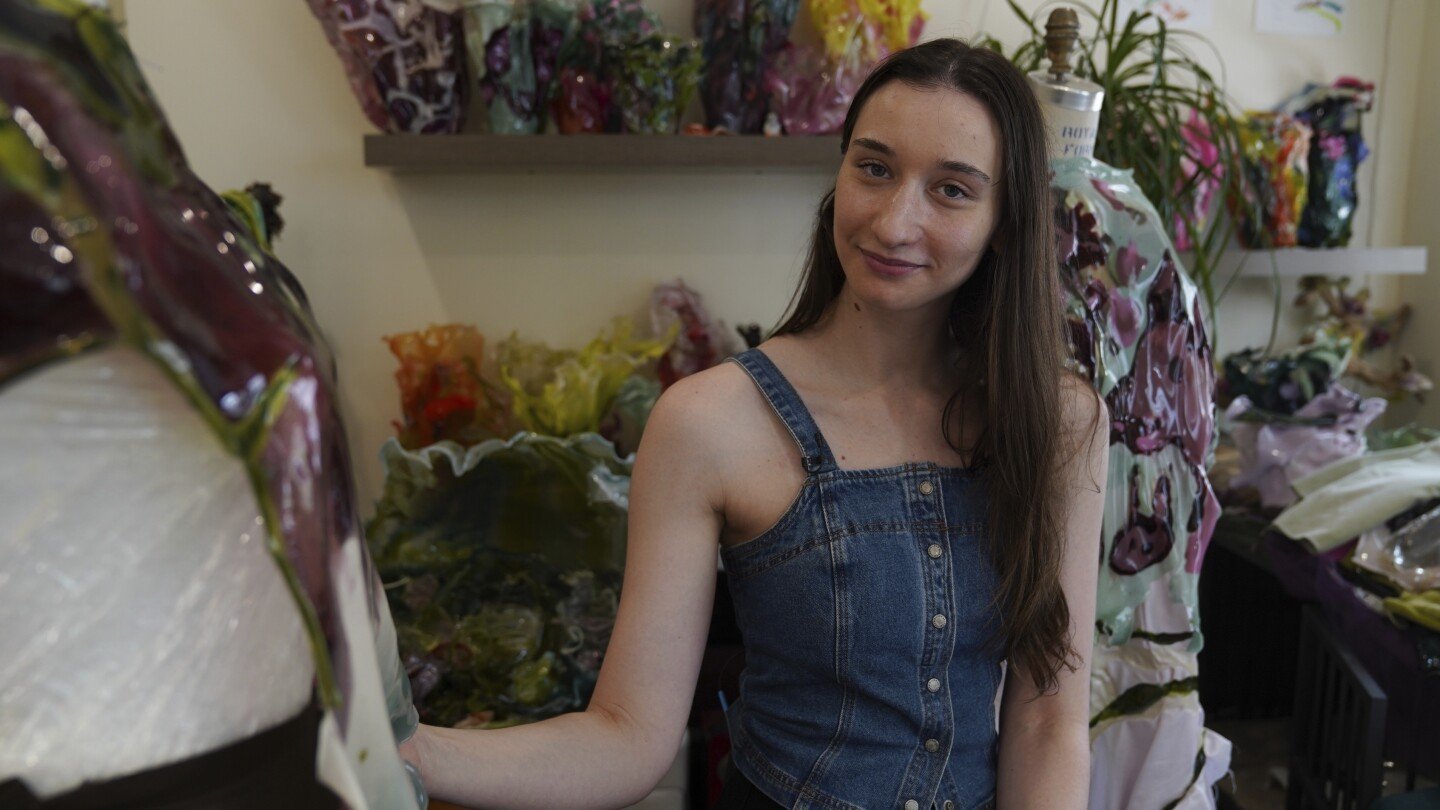Lifestyle
Growing share of US residents speak a language other than English at home

Spanish may be the most spoken language at home behind English, except in three U.S. states, but the second most-popular, non-English languages used in each state show off the diversity of the United States in unexpected places, whether it’s Korean in Alabama or Vietnamese in Kansas.
Almost 22% of U.S. residents age 5 and older spoke a language other than English at home, double the share from four decades ago, according to figures released Tuesday by the U.S. Census Bureau, and it varied by state. In California, 44% of residents spoke a language other than English at home, while it was 2.5% in West Virginia.
The United States is a multilingual nation due to immigration, despite recent crackdowns by the Trump administration, said William Frey, a demographer at The Brookings Institution.
“This is a big part of who we’ve been over a long period of time,” Frey said.
President Donald Trump earlier this year issued an executive order designating English as the official language in the U.S.
Spanish was spoken at home by 13.2% of speakers, and it was the top non-English language spoken at home in every state but Hawaii, Maine and Vermont. In Maine and Vermont, home to French Canadian communities, French was the most popular non-English language, and in Hawaii, it was Iloko, a Filipino language.
Here’s a look at where languages are spoken in the United States.
Arabic
Outside of English and Spanish, Arabic was the most spoken language at home in Iowa, Michigan, Ohio, Tennessee and West Virginia. The Detroit, Michigan, area has more Arabic speakers than any other metro area.
Central Yup’ik
About 1 out of 7 Alaskans who speak a language other than English at home did so in Central Yup’ik, making the native language the second most common non-English language behind Spanish in Alaska.
Chinese
Chinese was the second-most common non-English language spoken at home in Delaware, Missouri, New York, Pennsylvania and Washington. If all Chinese dialects are combined, it would be the third most spoken language in California behind English and Spanish.
French
Although it was the dominant non-English language in Maine and Vermont, French was the second most-common non-English language in Louisiana, Maryland, New Hampshire and North Carolina.
German
German was the most spoken language behind English and Spanish in eight states — Colorado, Idaho, Indiana, Kentucky, Montana, North Dakota, South Carolina and Wyoming. In total, more than 871,000 people over age 5 spoke German at home in 2021, compared to 1.6 million in 1980.
Haitian
Florida had almost a half million Haitian speakers, making it the most common language behind English and Spanish. The Sunshine State has the nation’s largest Haitian population.
Hmong
In Minnesota and Wisconsin, Hmong was the second-most spoken non-English language at home. Many Hmong people settled in the Upper Midwest states after fleeing Southeast Asia in the mid-1970s following the Vietnam War.
Korean
Korean was the most spoken language in Alabama and Virginia behind English and Spanish.
Lakota
In South Dakota, the Lakota dialect of the Sioux people was the most common language spoken behind English and Spanish.
Marshallese
The language of the Marshall Islands was the second-most spoken non-English language in Arkansas, where the community is concentrated in the northwest part of the state.
Navajo
Arizona and New Mexico had the most Navajo speakers in the United States. The Navajo Nation extends into Arizona and New Mexico, where the indigenous language was the second-most popular non-English speech in those two states.
Polish
Despite a nationwide decline in speakers, Polish was Illinois’ second-most common non-English language behind Spanish, primarily due to the Chicago area having one of the nation’s largest Polish communities.
Portuguese
Connecticut, Massachusetts, New Jersey and Rhode Island have some of the largest concentrations of Portuguese speakers in the U.S., making it the most spoken language in these states behind English and Spanish. It also is the second-most common non-English language in Utah, which is home to missionaries who served in Brazil and explains its popularity, according to the University of Utah.
Tagalog
The Filipino language was prevalent in California, Hawaii and Nevada, where it was the second-most popular non-English tongue.
Vietnamese
In Georgia, Kansas, Mississippi, Nebraska, Oklahoma, Oregon and Texas, Vietnamese was the most popular language behind English and Spanish, reflecting that people who speak different languages are no longer concentrated in big cities that serve as entry points for immigrants.
“People of different backgrounds are dispersed to different parts of the country,” Frey said.
___
Follow Mike Schneider on the social platform Bluesky: @mikeysid.bsky.social.
Lifestyle
Man charged after kilt-wearing attacker smashes case holding Scotland’s Stone of Destiny

LONDON (AP) — A man from Australia has been charged with “malicious mischief” for allegedly smashing a glass case holding the Stone of Destiny, an ancient symbol of Scottish nationhood.
Arnaud Harixcalde Logan, 35, appeared at Perth Sheriff Court on Monday to face the charge, which is similar to vandalism.
Logan, whose address was given as Sydney, wasn’t asked to enter a plea and was ordered detained until a hearing next week.
Police said that they were called to a “disturbance” at Perth Museum in central Scotland on Saturday, after reports of a kilt-wearing man attempting to smash the case containing the royal rock.
The 335-pound (150-kilogram) sandstone block is also known as the Stone of Scone (Skoon) — and was used in the crowning ceremonies of medieval Scottish monarchs at Scone Abbey, near Perth. It was stolen by England’s King Edward I in the 13th century and taken to Westminster Abbey in London, where it was installed under the seat of the coronation chair.
It has been used in coronations at the abbey ever since — first of English and then of British monarchs The English and Scottish crowns were united under one monarch in the 17th century.
The stone’s presence in London long irked Scottish nationalists. In 1950, it was stolen from Westminster Abbey by four Glasgow university students, but was returned in time for the coronation of Queen Elizabeth II in 1953.
It was given back to Scotland in 1996, 700 years after its seizure, and displayed in Edinburgh Castle, with the understanding that it would return to England for use in future coronations. Sensitivities around the stone meant that it had to be moved to London in secrecy and amid tight security for the coronation of King Charles III in 2023.
Last year it was put on display at the newly renovated Perth Museum where, according to the building’s website, there are “a range of 24/7 security measures in place at the Museum to protect this precious object.”
Culture Perth and Kinross, which oversees the museum, said the stone wasn’t damaged in the incident.
Lifestyle
These flavor-packed pork burgers were inspired by Indian street food

These flavor-packed burgers are a spin on a spiced pork sausage from Goa in southern India, based on the garlicky, European-style chouriço introduced by Portuguese settlers. To combat the humidity of the region and prolong the shelf life of the sausage, the meat is heavily salted and flavored with a mixture of spices and tangy vinegar.
Goan sausage is ubiquitous in southern India, where you can find it sold at street food carts and high-end restaurants alike, sometimes baked into a bun or minced and stuffed between layers of fried naan.
In this recipe from our cookbook “ Milk Street 365: The All-Purpose Cookbook for Every Day of the Year,” we take inspiration from those burger-like sandwiches, using a combination of grated garlic, garam masala, cumin, paprika and cayenne to give the all-pork patties deep, complex flavor and a rusty hue. Grating the garlic ensures it melts into the meat without any distracting bits. Instead of naan, we use classic hamburger buns.
Egg and panko bread crumbs help the patties keep their shape. Don’t undermix the pork mixture; be sure to combine it well so the breadcrumbs and seasonings are evenly distributed.
These burgers are especially delicious topped with yogurt, torn fresh mint leaves and thin slices of cucumber or tomato.
Start to finish: 35 minutes
Servings: 4
Ingredients:
⅔ cup panko breadcrumbs
¼ cup plain whole-milk yogurt, plus more to serve
5 teaspoons garam masala
5 teaspoons sweet paprika
1 tablespoon ground cumin
½ teaspoon cayenne pepper
2 large egg yolks
2 medium garlic cloves, finely grated
Kosher salt and ground black pepper
1 pound ground pork
2 tablespoons grapeseed or other neutral oil
4 hamburger buns, toasted
Directions:
In a large bowl, combine the panko, yogurt, garam masala, paprika, cumin, cayenne, egg yolks, garlic, ¾ teaspoon salt, ½ teaspoon pepper and ¼ cup water. Using a fork, mash the mixture into a smooth paste. Add the pork and mix with your hands until evenly combined. Form into 4 patties, each about 4 inches in diameter, place on a large plate and refrigerate for 15 minutes.
In a 12-inch nonstick skillet over medium, heat the oil until barely smoking. Add the burgers and cook until well browned, 7 to 8 minutes. Flip, reduce to medium-low and continue to cook until the patties are well browned on the second sides and the centers reach 160°F, another 5 to 7 minutes. Transfer to a clean plate, tent with foil and let rest for 5 minutes. Serve on the buns with additional yogurt on the side.
EDITOR’S NOTE: For more recipes, go to Christopher Kimball’s Milk Street at 177milkstreet.com/ap
Lifestyle
Fashion designers experiment with natural supplies called biomaterials

NEW YORK (AP) — At her kitchen stove, fashion designer Caroline Zimbalist looks like an alchemist at work as she stirs a pot full of corn starch and a thickener made from seaweed. The peppermint-scented mixture glitters as she carefully pours it into silicone molds of hearts and leaves.
When the material hardens, Zimbalist will stitch it into unique, made-to-order dresses that she sells on her website. She hopes her designs, which have been worn by celebrities including Chappell Roan, will put a spotlight on materials that aren’t sourced from planet-polluting fossil fuels, such as oil.
“It’s almost like a vessel to show the world,” she said.
Other small-scale designers are testing out tapioca, gelatin and other kitchen-shelf ingredients. Meanwhile, big names such as Adidas and Hermes have experimented with mushroom leather, while the Lycra brand is incorporating a new largely corn-based material into stretch fabric. Some experts are skeptical that these textiles — commonly referred to as biomaterials — will go mainstream, but designers such as Zimbalist hope their experiments will set an example for larger brands to follow.
Over 60% of clothing comes from petroleum-based synthetics like polyester, according to Textile Exchange, a nonprofit that promotes sustainable fashion. Manufacturing those materials creates emissions. Synthetic garments can also shed microplastics during washing. And as fast-fashion brands pump out new clothes for customers who expect new designs every few weeks, many garments end up in landfills.
A piece by fashion designer Caroline Zimbalist is displayed on Friday, June 6, 2025, in the Queens borough of New York. (AP Photo/Mary Conlon)
Zimbalist’s designs gained attention in 2024 when Roan wore one on “The Tonight Show.” The New York-based designer has since dressed stars such as comedian Atsuko Okatsuka and actors Anna Lore and Reneé Rapp. She takes commissions for custom clothing pieces, which cost between $150 and $1,200, via her website, which notes her “unique recipe of biodegradable and natural materials.”
As to whether her approach could be reproduced at a larger scale, Zimbalist says her materials could most practically be used to replace plastic hardware such as buttons and zippers. She acknowledges they can be sticky if not dried correctly, stinky if not treated and melty if exposed to extreme heat.
“Even incorporating it in small ways to start would be really strong,” she said.
Why biomaterials are hard to find
Fossil-fuel derived fabrics are ubiquitous because they’re cheap and made from plentiful raw materials, said Dale Rogers, an Arizona State University professor who studies supply chains.
Many clothes are also made of materials that come from plants or animals such as cotton, silk, wool and cashmere. But some have environmental impacts. Cotton uses a lot of water. Sheep and goats burp out methane.
Some biomaterials have gotten closer to widespread use. Mycelium leather, made from mushrooms, has been used to create luxury shoes, accessories and handbags by brands such as Stella McCartney, Lululemon, Adidas and Hermes.
Still, Rogers said he’s not convinced there’s enough demand for alternative materials to overcome companies’ aversion to the higher costs of producing them at a large scale.
“Honestly, in the end, cost drives almost all decisions,” he said.
Wrinkles in aiming for sustainability
Getting larger companies to use alternative materials depends on whether they will pay more for a fabric that matches their values, said Jon Veldhouse, the CEO of Qore LLC.
His company makes a product called Qira that replaces about 70% of the fossil-derived components of elastic synthetic fabrics with a corn-based material. The Lycra Company, which sells its stretchy material to major brands, initially expects to incorporate Qira in around 25 percent of its Spandex business, said Lycra chief brand and innovation officer Steve Stewart. But that option will be more expensive, and they haven’t yet announced any takers.
It can also be hard to measure the sustainability of farming practices that go into producing raw materials for new fabrics. Cargill is Qore’s partner and corn supplier, and it gets its grain from farmers in the vicinity of their processing plant. Veldhouse said many already plant cover crops or reduce tilling to lower environmental impact, but he couldn’t provide data on how many use those approaches.
Sarah Needham, a senior director at Textile Exchange, said it’s great to see a large organization such as Lycra making its production systems more sustainable. But she also stressed the industry needs to reduce its overreliance on virgin materials, perhaps considering agricultural waste as a source of fabric.
The role of experimental designers
Needham said experimental designers are often the ones coming up with those alternatives to virgin materials and building appetite for new approaches.
But small designers might not have the resources to test the biodegradability of their materials, which often do involve processing, even if it’s by hand, said Ramani Narayan, an engineering professor at Michigan State University.
“If I take something — like seaweed or whatever it is — and I apply a process to it, then I can no longer call it natural,” he said.
Zimbalist, the New York designer, acknowledges that her materials aren’t ready to replace conventional fabrics and that her work is more of “a piece that leads to larger conversations.”
Rogers, of Arizona State, thinks the fashion industry is a long way from meaningful change, but that “it’s incredibly valuable” for artists and specialty manufacturers to try new materials.
“What they’re doing is likely to have long-term benefit, maybe even after their lifetimes,” he added.
___
Follow Melina Walling on X @MelinaWalling and Bluesky @melinawalling.bsky.social.
Follow Kiki Sideris on X @KikiSideris.
___
The Associated Press’ climate and environmental coverage receives financial support from multiple private foundations. AP is solely responsible for all content. Find AP’s standards for working with philanthropies, a list of supporters and funded coverage areas at AP.org.
-

 Sports3 days ago
Sports3 days agoBill Ackman: Swift backlash after billionaire’s pro debut
-

 Europe5 days ago
Europe5 days agoBondi and Hegseth might be messing up — but they’re doing what Trump picked them to do
-

 Lifestyle4 days ago
Lifestyle4 days agoSebeiba festival in Algeria carries on ancient tradition
-

 Africa5 days ago
Africa5 days agoGreece blocks asylum claims after surge in migrant arrivals
-

 Lifestyle4 days ago
Lifestyle4 days agoHealthy workday snacks include a smart mix of energy-boosters
-

 Lifestyle3 days ago
Lifestyle3 days agoOne Tech Tip: All the ways to unsubscribe, after ‘click-to-cancel’ was blocked
-

 Sports3 days ago
Sports3 days agoMarc and Álex Márquez: Two brothers, one title dream – MotoGP’s high stakes sibling rivalry
-

 Asia5 days ago
Asia5 days agoSouth Korea’s former President Yoon Suk Yeol back in custody over insurrection probe




